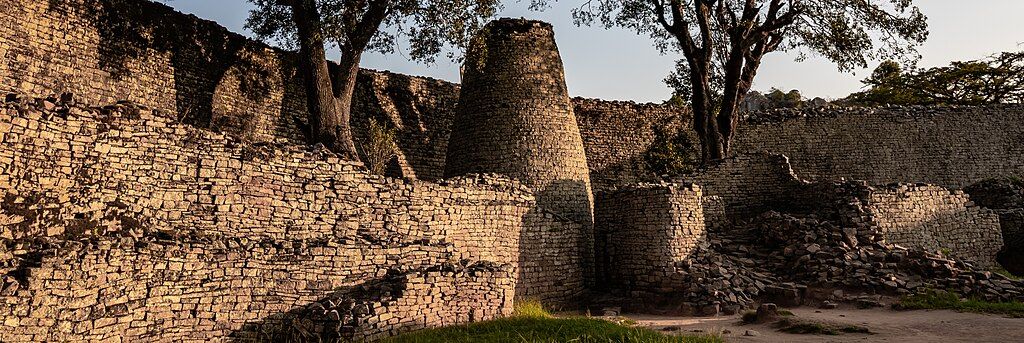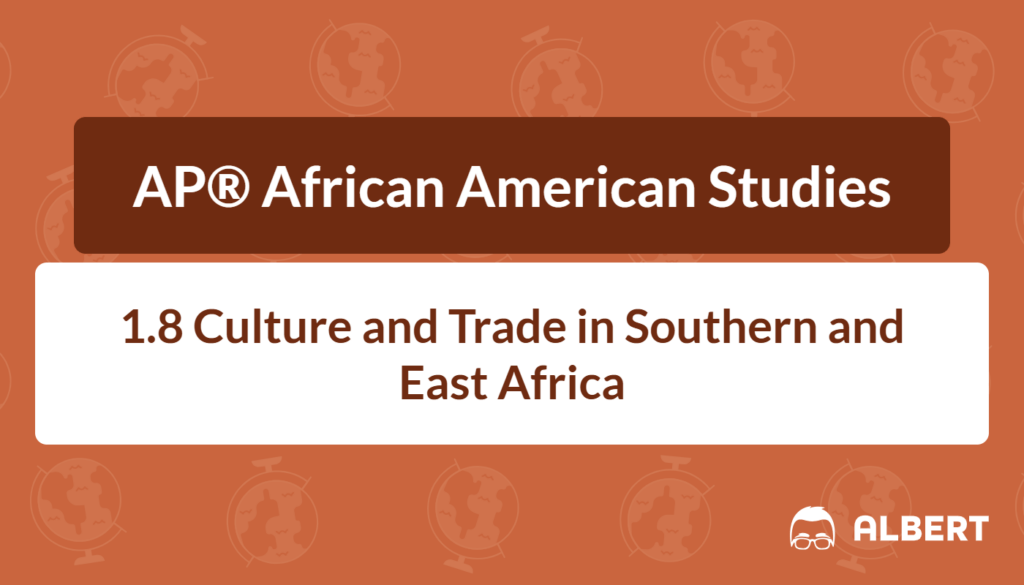What We Review
Culture and Trade in Southern and East Africa: A Study Guide for AP® African American Studies Students
Understanding the relationship between culture and trade in Southern and East Africa reveals how ancient societies thrived and influenced global connections. This history involves monumental stone enclosures, bustling coastal ports, and shifting power dynamics. It also helps reveal the ways in which African societies contributed to long-distance trade networks, shared religious practices, and economic growth.
However, it is often challenging to keep track of the many factors that shaped these kingdoms and city-states. The following sections break down major points related to Great Zimbabwe, the Swahili Coast, and the slave trade. These highlights will show why culture and trade remain central topics in AP® African American Studies.
The Kingdom of Zimbabwe and Great Zimbabwe
Importance of Great Zimbabwe’s Stone Architecture
Great Zimbabwe served as the capital city for the Kingdom of Zimbabwe from the twelfth to the fifteenth centuries (EK 1.8.A.1). The Shona people, who built and inhabited Great Zimbabwe, became wealthy by trading gold, ivory, and cattle (EK 1.8.A.1). The kingdom’s prosperity is also reflected in its impressive stone architecture, which still stands as a symbol of Shona innovation.
These stone structures were not simply houses or public buildings. Instead, they served as well-planned fortifications and social centers. The Great Enclosure—one of the most famous parts of the site—functioned as a space for religious ceremonies and administrative activities (EK 1.8.A.2). Within the Great Enclosure sits a conical tower, believed to have served as a granary, showcasing the kingdom’s agricultural abundance.

How Architecture Reflects Societal Values
Great Zimbabwe’s stone walls were built without mortar, which demonstrates advanced masonry skills. Furthermore, the conical tower points to a society that took pride in managing resources, especially grain. Therefore, these massive walls and structures provided both defense and areas for worship.
- Tall, thick walls suggested the Shona people’s desire for security.
- Granary towers allowed them to store surplus crops.
- Stone-based building methods withstood weather changes and signified the kingdom’s wealth.
Accordingly, these robust structures became an enduring symbol of African autonomy and technological success (EK 1.8.A.3).
Economic Factors: Gold, Ivory, and Cattle Trade
Trade in gold, ivory, and cattle enabled the Shona to develop diplomatic ties with neighboring communities. Great Zimbabwe’s location near key resources and along strategic trade routes made it a powerful economic force. As a result, merchants from other regions valued these commodities, creating a steady flow of wealth (LO 1.8.A).
For instance, gold from inland mines traveled along routes that linked Great Zimbabwe to the East African coast. Traders on the Swahili Coast then exchanged these goods with merchants from the Middle East and Asia. In turn, this network brought diverse cultural influences to the Shona, including new ideas about technology, religion, and governance.
Great Zimbabwe’s Impact on Trade Networks
Connecting with the Swahili Coast
During the kingdom’s peak, Great Zimbabwe was connected to the Swahili Coast through complex trade routes (EK 1.8.A.1). Goods such as gold, ivory, and animal skins flowed eastward, while items like glass beads and textiles arrived from Asia and the Middle East. Consequently, trading partnerships linked interior parts of Africa with distant markets. These connections helped Great Zimbabwe flourish economically and influenced cultural changes in the region.
Influence on Cultural Exchange
Trade was not only about buying and selling goods. It also facilitated the spread of languages, religious beliefs, and social customs. As Shona merchants met foreign traders, new ideas and practices traveled between them. For example, certain aspects of architecture and artistic design in Great Zimbabwe may have been influenced by interactions with Arab or Persian traders.
Therefore, Great Zimbabwe stands as a testimony to how strong economic ties can encourage cultural growth. These interactions between the Shona and other groups forged a legacy of shared knowledge, faith traditions, and market strategies.
The Swahili Coast: City-States and Cultural Connections
Geographic Significance of the Swahili Coast
The Swahili Coast stretches from Somalia to Mozambique (EK 1.8.B.1). Since it lies along the Indian Ocean, this coastal region became a gateway linking Africa’s interior to commercial centers in Arabia, Persia, India, and China. Between the eleventh and fifteenth centuries, numerous city-states—such as Kilwa, Mogadishu, and Mombasa—developed into hubs for merchants from different parts of the world (EK 1.8.B.1).
- Coastal ports exchanged goods like spices, precious metals, and textiles.
- Monsoon winds in the Indian Ocean allowed merchants to plan voyages for optimal sailing times.
- City-states formed alliances and rivalries to protect trade privileges.
Shared Language and Religion
Swahili, a Bantu language that integrated Arabic vocabulary, served as the lingua franca for traders and inhabitants across these city-states (EK 1.8.B.2). This common language eased communication among diverse groups. Additionally, Islam united many residents of the Swahili Coast and influenced social norms, business contracts, and scholarship. This combination of a shared tongue and religious faith contributed to a formidable sense of identity among coastal populations (EK 1.8.B.2).
European Influence and the Decline of Swahili City-States
The Rise of Portuguese Control
Starting in the sixteenth century, Portuguese explorers reached the East African Coast, seeking to dominate the Indian Ocean trade (EK 1.8.B.3). They used military force and established fortified settlements to ensure control over shipping lanes. Next, they targeted major city-states like Kilwa and Mombasa. As they gained power in the region, local rulers experienced a decline in autonomy.
Under Portuguese authority, taxes were sometimes imposed on commerce, diminishing profits. Therefore, the once-thriving trade networks that linked the Swahili Coast to wider markets experienced disruption. This change also restricted the independent growth of some city-states.
Changing Power Dynamics and Trade
European colonization shifted regional power balances. Because the Portuguese wanted to redirect trade toward Europe, they placed new market pressures on local communities. In turn, some city-states attempted to resist foreign rule, but their resources could not withstand the advanced naval technology of the Portuguese. As a result, the course of trade in the Indian Ocean changed, and the era of independent Swahili city-states began to wane.
Conclusion
Culture and trade in Southern and East Africa left a lasting legacy on the continent’s economic and social landscape. The Kingdom of Zimbabwe and its capital city, Great Zimbabwe, provide insight into how shared resources and bold architectural achievements helped a society gain prominence (LO 1.8.A). Meanwhile, the Swahili Coast city-states demonstrated how geographic location, common languages, and religions influence trade expansions and alliances (LO 1.8.B).
These stories remind students that African empires and city-states were vibrant centers of exchange well before European influence took hold. They also highlight the darker side of commerce by revealing how exploitation, especially through the East African slave trade, shaped local histories. Recognizing these multifaceted narratives helps deepen understanding of Africa’s role in early global trade and the ongoing significance of African heritage.
Required Sources
- Map Showing Indian Ocean Trade Routes from the Swahili Coast
- This map highlights the vast network of maritime paths linking African ports to Arabia, India, and beyond. It shows why the Swahili Coast became such a significant hub for commerce. By studying these routes, it becomes clearer how resources (like gold and ivory) moved from the interior to coastal markets.
- Photographs of Great Zimbabwe’s Walls and Stone Enclosures, Twelfth to Fifteenth Century
- Visual evidence of the massive stone walls reinforces descriptions of their construction and purpose. Observing details such as the height of the Great Enclosure or the shape of the conical tower reveals the Shona people’s architectural talents. This historical context helps illustrate the kingdom’s economic strength and self-sufficiency.
These sources show tangible evidence of trade connections, architectural advancements, and cultural exchange in Southern and East Africa. They also support the conclusion that diverse influences shaped regional developments well before outside European powers arrived.
Quick Reference Chart
| Term | Definition |
| Great Zimbabwe | A medieval city known for its impressive stone structures. It was the capital of the Kingdom of Zimbabwe from the twelfth to fifteenth centuries. |
| Swahili Coast | A coastal region stretching from Somalia to Mozambique, known for its city-states that thrived on maritime trade from the eleventh to fifteenth centuries. |
| Swahili Language | A Bantu lingua franca enriched with Arabic terms, used among coastal traders and communities to communicate efficiently. |
| East African Slave Trade | The capture and sale of enslaved individuals along the East African coast, forming part of a broader international system of forced labor. |
| Portuguese Influence | The effect of Portuguese arrival in the sixteenth century, which led to control of trade routes and the decline of Swahili city-states’ independence. |
| Conical Tower | A tower within the Great Enclosure at Great Zimbabwe, believed to have served as a granary, symbolizing agricultural abundance. |
| Indian Ocean Trade Routes | Maritime paths connecting East Africa with Arabia, Persia, India, and China, facilitating cultural and economic exchange. |
Sharpen Your Skills for AP® African American Studies
Are you preparing for the AP® African American Studies test? We’ve got you covered! Try our review articles designed to help you confidently tackle real-world AP® African American Studies problems. You’ll find everything you need to succeed, from quick tips to detailed strategies. Start exploring now!
Need help preparing for your AP® African American Studies exam?
Albert has hundreds of AP® African American Studies practice questions, free response, and full-length practice tests to try out.









